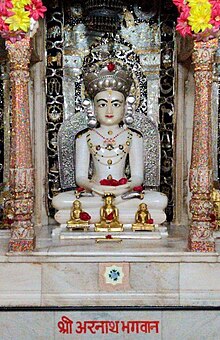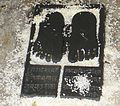| Aranatha | |
|---|---|
| 18th Tirthankara, 7th Chakravarti, and 13th Kamadeva | |
 The idol of Lord Aranatha in a Jinalaya at Amritsar,Punjab The idol of Lord Aranatha in a Jinalaya at Amritsar,Punjab | |
| Venerated in | Jainism |
| Predecessor | Kunthunatha |
| Successor | Mallinatha |
| Symbol | Fish |
| Height | 30 Bows (90 Metres) |
| Age | 84,000+ |
| Color | Golden |
| Genealogy | |
| Born | Hastinapur |
| Died | Sammed Shikhar |
| Parents |
|
| Dynasty | Ikshvaku dynasty |
| Part of a series on |
| Jainism |
|---|
 |
| Philosophy |
EthicsEthics of Jainism
|
| Jain prayers |
| Major figures |
| Major sectsSchools and Branches |
| Jain literature |
| Festivals |
| PilgrimagesTirth |
| Other |
Aranatha, also known as Arnath was the eighteenth Jain Tirthankar of the present half cycle of time (Avasarpini). He was also the eighth Chakravartin and thirteenth Kamadeva. According to Jain beliefs, he was born around 16,585,000 BCE. He became a siddha i.e. a liberated soul which has destroyed all of its karmas. Aranath was born to King Sudarshana and Queen Devi (Mitra) at Hastinapur in the Ikshvaku dynasty. His birth date was the tenth day of the Migsar Krishna month of the Indian calendar.
Life
Like all other Chakravartin, he also conquered all the lands and went to write his name on the foothills of mountains. Seeing the names of other Chakravartin already there, he saw his ambitions dwarfed. He then renounced his throne and became an ascetic for penance. At an age over 84,000 years he and attained Moksha (liberation) on Mount Shikharji.
Worship
Svayambhūstotra by Acarya Samantabhadra is the adoration of twenty-four tirthankaras. Twenty slokas (aphorisms) of Svayambhūstotra are dedicated to Tirthankar Aranath. One such sloka is:
O Passionless Lord Aranatha! Your physical form which is free from all vestiges of ornaments, clothes and weapons, and the embodiment of unalloyed knowledge, control of the senses, and benevolence, is a clear indication that you have vanquished all blemishes.
— Svayambhustotra (18-2-12)
As a historical figure
At Mathura, there is an old stupa with the inscription of 157 CE. This inscription records that an image of the tīrthankara Aranath was set up at the stupa built by the gods. However, Somadeva Suri stated in Yashstilaka and Jinaprabha Suri in Vividha Tirtha Kalpa that the stupa was erected for Suparśvanātha.
Temples
- Navagarh Tirth
- Chaturmukha Basadi is a famous Jain temple located at Karkala in the Indian state of Karnataka. The temple is dedicated to Tirthankara Aranatha, Mallinath and Munisuvratnath.
- Prachin Bada Mandir, Hastinapur, Uttar Pradesh
-
 Chaturmukha basadi (Karnataka) dedicated to Tirthankara Aranath
Chaturmukha basadi (Karnataka) dedicated to Tirthankara Aranath
-
 Jain temple dedicated to Tirthankar Aranath
Jain temple dedicated to Tirthankar Aranath
-
 Prachin Bada Mandir, Hastinapur
Prachin Bada Mandir, Hastinapur
-
 Footprints at Aranath Tonk, Shikhar Ji
Footprints at Aranath Tonk, Shikhar Ji
See also
References
- Tandon 2002, p. 45.
- ^ Tukol 1980, p. 31.
- ^ von Glasenapp 1999, p. 308.
- Vijay K. Jain 2015, p. 118-129.
- Vijay K. Jain 2015, p. 122.
- Jain 2009, p. 77.
- Sandhya, C D’Souza (19 November 2010), "Chaturmukha Basadi: Four doors to divinity Last updated", Deccan Herald
Sources
- Johnson, Helen M. (1931), Aranathacaritra (Book 6.2 of the Trishashti Shalaka Purusha Caritra), Baroda Oriental Institute
- Jain, Vijay K. (2015), Acarya Samantabhadra's Svayambhustotra: Adoration of The Twenty-four Tirthankara, Vikalp Printers, ISBN 978-81-903639-7-6, archived from the original on 16 September 2015,
 This article incorporates text from this source, which is in the public domain.
This article incorporates text from this source, which is in the public domain. - Jain, Arun Kumar (2009). Faith & philosophy of Jainism. Delhi, India: Kalpaz Publications. ISBN 9788178357232.
- Tukol, T. K. (1980), Compendium of Jainism, Dharwad: University of Karnataka
- von Glasenapp, Helmuth (1999), Jainism: An Indian Religion of Salvation [Der Jainismus: Eine Indische Erlosungsreligion], Shridhar B. Shrotri (trans.), Delhi: Motilal Banarsidass, ISBN 81-208-1376-6
- Tandon, Om Prakash (2002) , Jaina Shrines in India (1 ed.), New Delhi: Publications Division, Ministry of Information and Broadcasting, Government of India, ISBN 81-230-1013-3
| Gods | |||||
|---|---|---|---|---|---|
| Philosophy | |||||
| Branches |
| ||||
| Practices | |||||
| Literature | |||||
| Symbols | |||||
| Ascetics | |||||
| Scholars | |||||
| Community | |||||
| Jainism in |
| ||||
| Jainism and | |||||
| Dynasties and empires | |||||
| Related | |||||
| Lists | |||||
| Navboxes | |||||
This biography of an Indian religious figure is a stub. You can help Misplaced Pages by expanding it. |
This Jainism-related article is a stub. You can help Misplaced Pages by expanding it. |